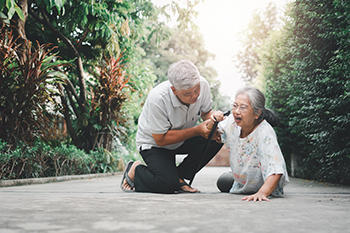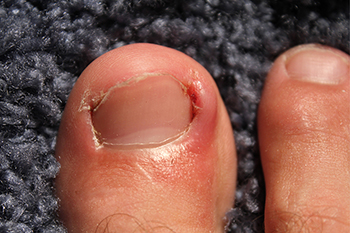Items filtered by date: October 2025
Causes and Prevention of Falls in Seniors

Falls among seniors often stem from changes in the feet and ankles that reduce stability and increase the risk of losing balance. Weakness in foot muscles, arthritis in the toe joints, or stiffness in the ankles can limit mobility and make walking less secure. Nerve damage or reduced sensation in the feet can cause difficulty in feeling the ground, which may lead to tripping or stumbling. Poorly fitting footwear, such as shoes that lack adequate support or flip-flops, can also increase the likelihood of a fall. Injuries from falls include sprains, fractures, or torn ligaments, which can have long-lasting effects on mobility and independence. A podiatrist can evaluate gait, check for structural changes in the feet, recommend supportive footwear, and, if needed, suggest surgery to correct deformities that impair balance. If you are a senior who has fallen or is experiencing stability issues, it is suggested that you schedule an appointment with a podiatrist for an exam and appropriate treatment.
Preventing falls among the elderly is very important. If you are older and have fallen or fear that you are prone to falling, consult with Adam Klein, DPM from Lynbrook, NY. Our practitioner will assess your condition and provide you with quality advice and care.
Every 11 seconds, an elderly American is being treated in an emergency room for a fall related injury. Falls are the leading cause of head and hip injuries for those 65 and older. Due to decreases in strength, balance, senses, and lack of awareness, elderly persons are very susceptible to falling. Thankfully, there are a number of things older persons can do to prevent falls.
How to Prevent Falls
Some effective methods that older persons can do to prevent falls include:
- Enrolling in strength and balance exercise program to increase balance and strength
- Periodically having your sight and hearing checked
- Discuss any medications you have with a doctor to see if it increases the risk of falling
- Clearing the house of falling hazards and installing devices like grab bars and railings
- Utilizing a walker or cane
- Wearing shoes that provide good support and cushioning
- Talking to family members about falling and increasing awareness
Falling can be a traumatic and embarrassing experience for elderly persons; this can make them less willing to leave the house, and less willing to talk to someone about their fears of falling. Doing such things, however, will increase the likelihood of tripping or losing one’s balance. Knowing the causes of falling and how to prevent them is the best way to mitigate the risk of serious injury.
If you have any questions, please feel free to contact our office located in Contact Us . We offer the newest diagnostic and treatment technologies for all your foot care needs.
Causes and Relief for Ingrown Toenails

An ingrown toenail occurs when the edge of a toenail grows into the surrounding skin, causing pain, redness, swelling, and sometimes infection. Common risk factors include wearing tight shoes, improper nail trimming, injury to the toe, or genetic predisposition. Symptoms often include tenderness along the nail edges, throbbing pain, and drainage, if an infection develops. Left untreated, ingrown toenails can worsen and interfere with daily activities such as walking or exercise. A podiatrist can provide effective treatment, from careful removal of the ingrown portion of the nail to guidance on proper nail care and footwear choices. If you are experiencing pain or signs of an infected ingrown toenail, it is strongly suggested that you promptly schedule an appointment with a podiatrist who can offer appropriate treatment solutions.
Ingrown toenails can become painful if they are not treated properly. For more information about ingrown toenails, contact Adam Klein, DPM of Lynbrook, NY. Our practitioner can provide the care you need to keep you pain-free and on your feet.
Ingrown Toenails
Ingrown toenails occur when a toenail grows sideways into the bed of the nail, causing pain, swelling, and possibly infection.
Causes
- Bacterial infections
- Improper nail cutting such as cutting it too short or not straight across
- Trauma to the toe, such as stubbing, which causes the nail to grow back irregularly
- Ill-fitting shoes that bunch the toes too close together
- Genetic predisposition
Prevention
Because ingrown toenails are not something found outside of shoe-wearing cultures, going barefoot as often as possible will decrease the likeliness of developing ingrown toenails. Wearing proper fitting shoes and using proper cutting techniques will also help decrease your risk of developing ingrown toenails.
Treatment
Ingrown toenails are a very treatable foot condition. In minor cases, soaking the affected area in salt or antibacterial soaps will not only help with the ingrown nail itself, but also help prevent any infections from occurring. In more severe cases, surgery is an option. In either case, speaking to your podiatrist about this condition will help you get a better understanding of specific treatment options that are right for you.
If you have any questions, please feel free to contact our office located in Contact Us . We offer the newest diagnostic and treatment technologies for all your foot care needs.
Reduce Foot Pain With Shockwave Therapy

Shockwave therapy treatments are administered outside the body and are non-invasive. A handheld transducer placed on the skin passes high-energy sound waves down into the injured tissue to increase blood flow. This activates the body’s natural healing process and reduces pain and inflammation. Shockwave therapy has provided fast results in treating heel pain, tendonitis, bursitis, and more with no needles or steroids.
Contact our office to learn more!
Understanding Ankle Tendonitis and Its Many Forms

Ankle tendonitis is inflammation of the tendons around the ankle joint, often caused by overuse, improper footwear, flat feet, or sudden increases in physical activity. Common types include Achilles tendonitis, posterior tibial tendonitis, and peroneal tendonitis. Symptoms may involve aching, swelling, stiffness, and tenderness along the affected tendon, especially after activity or in the morning. The area may appear red or warm and can become painful when walking, climbing stairs, or standing for long periods. The pain is usually localized but can radiate along the ankle or lower leg. A podiatrist can diagnose the specific type of tendonitis through a physical examination, medical history, and imaging studies, such as ultrasound or MRI. Treatment may include anti-inflammatory medications, custom orthotics, targeted exercises, and temporary immobilization. In more severe cases, advanced therapies or surgery may be needed. Since untreated tendonitis can lead to chronic pain or tendon rupture, it is suggested that you make an appointment with a podiatrist.
Ankle pain can be caused by a number of problems and may be potentially serious. If you have ankle pain, consult with Adam Klein, DPM from Lynbrook, NY. Our practitioner will assess your condition and provide you with quality foot and ankle treatment.
Ankle pain is any condition that causes pain in the ankle. Due to the fact that the ankle consists of tendons, muscles, bones, and ligaments, ankle pain can come from a number of different conditions.
Causes
The most common causes of ankle pain include:
- Types of arthritis (rheumatoid, osteoarthritis, and gout)
- Ankle sprains
- Broken ankles
- Achilles tendonitis
- Achilles tendon rupture
- Stress fractures
- Bursitis
- Tarsal tunnel syndrome
- Plantar fasciitis
Symptoms
Symptoms of ankle injury vary based upon the condition. Pain may include general pain and discomfort, swelling, aching, redness, bruising, burning or stabbing sensations, and/or loss of sensation.
Diagnosis
Due to the wide variety of potential causes of ankle pain, podiatrists will utilize a number of different methods to properly diagnose ankle pain. This can include asking for personal and family medical histories and of any recent injuries. Further diagnosis may include sensation tests, a physical examination, and potentially x-rays or other imaging tests.
Treatment
Just as the range of causes varies widely, so do treatments. Some more common treatments are rest, ice packs, keeping pressure off the foot, orthotics and braces, medication for inflammation and pain, and surgery.
If you have any questions please feel free to contact our office located in Contact Us . We offer the newest diagnostic tools and technology to treat your foot and ankle needs.
Proper Care for Small or Large Foot Wounds
 A cut on the skin is known as a laceration. If a laceration develops on the foot, it is beneficial to provide immediate care to help prevent painful foot conditions from arising. If the cut is small it may be treated with surgical tape, however larger cuts may require stitches. An x-ray may need to be performed if a piece of glass or small rock has entered the skin. Maintaining proper foot care can help with healing any existing wounds. This can be done by keeping the affected area clean and dry, and it may be helpful to use an antibiotic cream. If you would like additional information about how to care for foot wounds, please consult with a podiatrist.
A cut on the skin is known as a laceration. If a laceration develops on the foot, it is beneficial to provide immediate care to help prevent painful foot conditions from arising. If the cut is small it may be treated with surgical tape, however larger cuts may require stitches. An x-ray may need to be performed if a piece of glass or small rock has entered the skin. Maintaining proper foot care can help with healing any existing wounds. This can be done by keeping the affected area clean and dry, and it may be helpful to use an antibiotic cream. If you would like additional information about how to care for foot wounds, please consult with a podiatrist.
Wound care is an important part in dealing with diabetes. If you have diabetes and a foot wound or would like more information about wound care for diabetics, consult with Adam Klein, DPM from Lynbrook, NY. Our practitioner will assess your condition and provide you with quality foot and ankle treatment.
What Is Wound Care?
Wound care is the practice of taking proper care of a wound. This can range from the smallest to the largest of wounds. While everyone can benefit from proper wound care, it is much more important for diabetics. Diabetics often suffer from poor blood circulation which causes wounds to heal much slower than they would in a non-diabetic.
What Is the Importance of Wound Care?
While it may not seem apparent with small ulcers on the foot, for diabetics, any size ulcer can become infected. Diabetics often also suffer from neuropathy, or nerve loss. This means they might not even feel when they have an ulcer on their foot. If the wound becomes severely infected, amputation may be necessary. Therefore, it is of the upmost importance to properly care for any and all foot wounds.
How to Care for Wounds
The best way to care for foot wounds is to prevent them. For diabetics, this means daily inspections of the feet for any signs of abnormalities or ulcers. It is also recommended to see a podiatrist several times a year for a foot inspection. If you do have an ulcer, run the wound under water to clear dirt from the wound; then apply antibiotic ointment to the wound and cover with a bandage. Bandages should be changed daily and keeping pressure off the wound is smart. It is advised to see a podiatrist, who can keep an eye on it.
If you have any questions please contact our office located in Contact Us . We offer the newest diagnostic and treatment technologies for all your foot and ankle needs.
